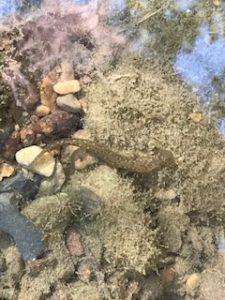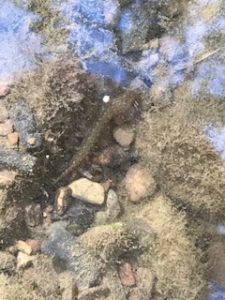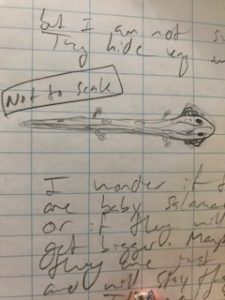October 5th was a bright sunny day with very few clouds in the sky. The weather was beautiful, and I got to spend 45 minutes basking in the 75 degree weather while I did my species observation. After looking around my sit spot for a few minutes I spotted a little tail poking out from under a leaf in the creek. I chose this organism because I had never seen anything like it before and I really wasn’t sure what it was. I was very curious to find out what it was. The organism was less than a foot away, which is probably why I could see it, as it was very small and very well Salamander

camouflaged. The leaf it was under was next to my rock that I have been observing, and I think that it, or some of its friends, most likely lives under this rock. After moving the leaf the organism was startled closer to me and into a patch of sunlight were it attempted to blend into the rocks. Closer observation let me see that it looked like a small salamander. At first I thought it was a fish, due to its tail and the way it swam when startled, but looking closer I saw it climbing around with small legs, which led me to believe it was a salamander. After I looked it up I found that it was a salamander, or rather a Southern Two-Lined Salamander larvae (Eurycea cirrigera).
I had to sit really still while observing the salamander because it became startled when it saw my shadow or when I got too close to it. I actually lost the original salamander that I was watching after I attempted to touch it and it swam away very quickly. Fortunately during the 45 minute period that I was there I got to observe 5 of these little salamanders. The salamanders were roughly two inches long and were very skinny, They had long tails and four very small legs. They were very hard to see since they camouflaged extremely well with the bottom of the creek. They were brown with two black stripes along their sides and sandy colored spots along their backs. They all looked the same so I think that they were all the same species. Not only were they afraid of me but at one point I watched two salamanders hide when a small crayfish began wandering around. I think this is because since crayfish are omnivorous larger ones probably eat these small salamanders. This was the only organism that I saw them interact with, as they mostly kept to themselves. At times they would lay really still along the bottom of the creek, not moving. When undisturbed for longer periods of time I watched one crawl around on top of rock underwater. The rock had algae on it and it appeared as if the salamander was digging around in it. I am not sure why, as they do not eat algae. My Salamander
larger ones probably eat these small salamanders. This was the only organism that I saw them interact with, as they mostly kept to themselves. At times they would lay really still along the bottom of the creek, not moving. When undisturbed for longer periods of time I watched one crawl around on top of rock underwater. The rock had algae on it and it appeared as if the salamander was digging around in it. I am not sure why, as they do not eat algae. My Salamander
Adult Southern Two-Lined Salamanders live in and near streams occasionally wandering into forests. They move further into the streams for breeding, though not much is known about their breeding behavior though it is known that it occurs mostly in late April- May. The eggs are laid a few weeks later and hatch in May-June however the newly hatched larvae does not complete its growing until the next year. Though larvae is often thought of as an insect term, in this case it is the small, weak legged, mostly swimming version of the salamander that hatches out of the egg. They do not get stronger legs until the next year and do not reach maturity until they are 2. They occur throughout most of the south, including Virginia, West Virginia, North and South Carolina, Indiana, and a few others.
This is a common species of salamander and are not considered endangered. They are predators, eating other salamander larvae, crayfish, insects, and isopods. The larvae only really eat midges and small bugs as they are too small and fragile to hunt bigger creatures. There are many predators for this type of salamander, as birds, snakes, as well as fish all can eat them. This is why they spend most of their time hiding  under things or blending in. Most interestingly, they are a very important part of nutrient cycles in their ecosystems.
under things or blending in. Most interestingly, they are a very important part of nutrient cycles in their ecosystems.
It was very challenging to identify this creature since I was looking at adult or juvenile salamanders and not larvae, it took me several hours to realize what I needed to be looking at. I looked up salamander larvae in Virginia to see what species lives here. Then I matched up pictures of the salamanders on the page versus the pictures that I took of the salamander that I saw. I enjoyed finding out what the salamander was but I did not enjoy the research process. It would have been more fun if I had not been looking up the wrong thing for so long, but that is a mistake that I can fix for the next time. I really enjoyed this sit-spot experience because I really wanted to know what species this was but it was also a more hands on experience than previous sit-spots and I liked that aspect of it. The best part was when I finally able to identify the species.
identify the species.
My Sketch Salamander
References Sited
Matthes, J. (n.d.). Eurycea cirrigera (Southern Two-lined Salamander). Animal Diversity Web. Retrieved October 7, 2020, from https://animaldiversity.org/accounts/Eurycea_cirrigera/
Southern Two-Lined Salamander (Eurycea cirrigera) – Indiana Herp Atlas. (n.d.). Www.Inherpatlas.Org. Retrieved October 6, 2020, from https://www.inherpatlas.org/species/eurycea_cirrigera

As a kid, I enjoyed catching and releasing all of the salamanders, so it was really interesting to read about your observations. The ones we would see were poisonous so they wouldn’t get eaten unlike the ones you saw. I can also definitely agree with the satisfaction of being able to finally find what you’re looking for.
You did a great job, Emily! I found your blog post to be super interesting, and I think that it was really cool that you were able to observe salamanders. I also wanted to say how I loved that you tried to physically touch the salamanders to get a full analysis of the species; I would have been much too scared to even have tried to touch the creatures. Also, I’m really happy that you were able to identify the species in the end of your study, but I am sorry that it took so long to finally come up with the correct search results.